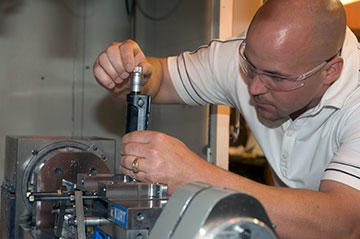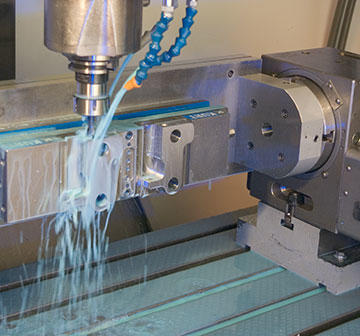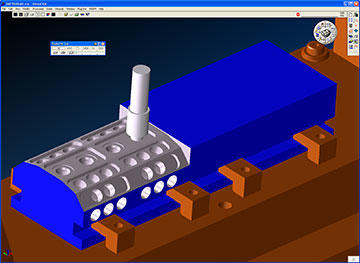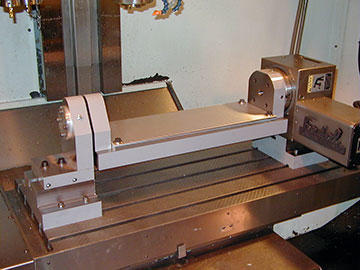
Star Metal Products, Westlake, OH, needed the accuracy of a horizontal CNC, but found the cost prohibitive. As an alternative, the company thought a trunnion added to its VMC would provide the rotary capability with the trunnion supported on both ends. It turned out the firm was more than 10 years ahead of its time in 1995.
The company has been in business for 48 years, occupying a 25,000 ft2 facility, with National Machinery as its primary customer. Wanting to optimize production and reduce operating cost, Dave McCray, Star Metals engineering manager, sought the right device that would give his company the capability of a horizontal CNC at a fraction of the cost. He was in for disappointment.
He found trunnions with integrated vises could not be changed out, accommodate castings, were too flimsy to hold required tolerances and, with or without these limitations, far too expensive. McCray believed his company could build its own trunnion to best meet its requirements. But, time being a valuable commodity, it couldn’t be spent for infrastructure improvements.
Ten years later, under increased competition and pressure to evolve into a job shop, increasing productivity could not wait. Thinking that the market should have progressed substantially, McCray researched the availability of an adequate trunnion. He found the market as lacking and expensive as a decade earlier.
“Those I found weren’t rigid enough,” he said, “We needed something with workholding flexibility, maximum rotation, and rigid enough for indexable drilling and machining hard steels. They are not available for the Fadal 4020 and our preferred machines.”
Resurrecting his 10-year old idea, McCray made time to pursue it. The shop had two seats of UGS Solid Edge, which account for the majority of the company’s CAD modeling work. It had one seat of GibbsCAM for handling NC programming of all the company’s machines, but needed more.
As the shop got busier, a second GibbsCAM seat was added for a part-time programmer. While Solid Edge is busy, McCray finds himself modeling with GibbsCAM for some projects. It is his preferred method in most cases.

The shop’s introduction into CAD/CAM began more than a decade ago with GibbsCAM. Star Metal used it to model and program everything. With increased business, the company found itself growing fast and falling behind CAD modeling. That, and the need to create assembly drawings and model parts with complex surfaces, provided the impetus for Star Metal to purchase Solid Edge.
“Until then, GibbsCAM served all of our needs,” McCray said, “but we had to free it up for NC programming. I know how to use a few other CAM packages, but in my machining experience, I found GibbsCAM the most capable.”
Hundreds of jobs run through the Star Metal shop every month. What it doesn’t model with Solid Edge, or with GibbsCAM, arrives in various CAD formats.
“We get Solid Edge, SolidWorks, Pro-ENGINEER, Autodesk SAT files, Autodesk Inventor, even DXF, and IGES files,” McCray said. “GibbsCAM opens the files directly and we program parts from all of them. In its ten years at the shop, we’ve never run into a part it couldn’t program easily.”
McCray said the toughest part of modeling the trunnion was finding time. “Since they are 2D, the components were easy, with no 3D surfaces. I had been designing the trunnion in my mind for a couple of years, so I did most of it on the fly.”
He modeled the table and the machine, and then the indexer. Then he created the tailstock assembly and the centering adjustment. One challenge was to maximize the size of the work envelope and use as much of the machining center’s available travel without restricting workpiece size and rotation. To overcome that obstacle, he used CAD and CAM in concert, which reduced the calculations required and increased McCray’s confidence in design.
“I rely heavily on GibbsCAM’s visualization,” he said. “Just as I use Solid Edge to visualize design models, I use GibbsCAM to visualize toolpaths, and with GibbsCAM’s Cut Part Rendering, I visualize and check surface finish and minimize wasted tool motion.”
McCray was able to visualize the trunnion model, move it to other coordinate systems, check clearances, and design for the largest work envelope. He relied on the GibbsCAM Machine Simulation module for verification and optimization. To reduce modeling time, he got a GibbsCAM model of the Fadal from a friend, modified it, and “mounted” his trunnion and indexer, running simulations to verify travel, trunnion rotation, and workpiece size.
“It was awesome,” McCray said. “After simulating NC programs in real time, I was as competent as I am with the other Gibbs visualization tools. I started machining parts.”
McCray recently completed the project with a solid and functional trunnion, which incorporates 86 individual parts, including fasteners, machined from 2" thick, 4140 steel.
The requirement for flexibility was met with removable subplates, which allow fixturing castings, as well as standard workholding devices.
The South Milwaukee facility has served as the company’s headquarters since 1893 and houses nearly 1,400 employees. This total includes seven programmers who support more than 25 CNC machine tools in a shop that makes components and spare parts for nearly all the equipment Bucyrus and its acquisitions have ever manufactured. While the shop has an assortment of mid-sized to large HMCs, VMCs and lathes, the CNCs that accommodate the largest parts are a pair of identical Ingersoll Innse Aries 3 horizontal boring mills. These massive machines have 130-hp spindle motors; X-axis travels of 670 inches and Y-axis travels of 216 inches; Z and W axes; and dozens of toolholders, automatic toolchangers and tool magazines.
Bucyrus uses SolidWorks for modeling parts and Cadra for some 2D drawings. Programmers import SolidWorks models and Cadra geometry into GibbsCAM to generate NC code. “Sometimes, we have to work from drawings made in the 1920s to make parts for customers using old machines,” says Jim Koehler, machine shop programming supervisor. “I don’t recall ever turning down a customer who needed a part.” In cases such as these when a CAD model is not available, programmers create the geometry in GibbsCAM.

“We can mount anything we want on a single subplate,” McCray said. Different subplates can be used for specific applications. The 24" work envelope allows a full 360-degree swing of an 18"×18"×9" block.
McCray said the weight of the design does not sacrifice accuracy because it is suspended by the head stock and indexer on one end and the tailstock on the other
“The unit is so tight and rigid,” McCay said, “that it holds the same tolerances as the machine and indexer.” He credits this to trunnion rigidity, built-in centering adjustments, and GibbsCAM positioning.
Positioning in CAM is critical to Star Metal, even when it had no indexer for rotary motion. Once, to machine an aircraft landing gear, the company mounted the workpiece on the machine with angle blocks. Then, as the 3D model was tilted to a new angle on screen, the workpiece was manually tilted on the machine to match.
“The machine setup was brutal,” laughs McCray, “but we did the job.”
The trunnion’s head and tailstock are adjustable in two axes, about 0.1", to make exact centering on the table easier than tapping and tightening mounting bolts in the T-slots. The unit is rotated in one direction, indicated, rotated in the other, and indicated. If it’s off center, it can be dialed in.
The unit is routinely tilted in one direction and then the other and holds half a thousandth in either direction, with repeatability.
“Even when we have to machine to a given line, tilting in both directions, we still hold position to 0.0005", and we never use the brake to hold the indexer,” he said. “It’s as good as the machine and indexer. Most of the trunnions available are loose, made for cutting soft materials, and not very durable. With ours, we can cut D2 steel.”
The trunnion was developed from necessity, since McCray said Star couldn’t afford a $200,000 outlay for a horizontal CNC. But, it couldn’t continue using manual horizontal machines, because of too many setups.
“The more you handle a part, the more it costs. A vertical’s standard 4th axis restricts you to what you can fasten to the face plate, which only holds the part on one end. We turned a standard VMC into a trunnioned machine and now, in the average week, we run 100 jobs through the trunnion.”
When asked about payback, McCray said, “For us, it was shorter, but is one week too long?”
“Installing the trunnion is easy and setup is a breeze,” Ed Perdue, Star Metal’s CNC Manager, said. It is easy to incorporate into a conventional VMC.
Perdue compares the trunnion on a Fadal 4020 to running jobs on their Makino VS56, a 3-axis machining center made for high-speed 3D milling.

“We cut machining time 50 percent, because we didn’t have to move parts in and out,” Perdue said.
The trunnion’s first benefit was the elimination of hundreds of setups each week. With the ability to rotate to any angle, five faces can be machined with a single setup. The trunnion permits mounting several workpieces at once, reducing downtime in production machining.
As a second benefit, it eliminates use of form cutters, required on the old mills, for cutting angles.
A third advantage is, that by its design, it provides the flexibility to mount castings or raw stock as needed.
The greatest reward is that the trunnion, on a single Fadal 4020, made parts the first day it was mounted, and eliminated the use of eight manual horizontal mills within two weeks, which freed manpower. The machinists previously running the old mills are now running vertical machining centers. In weekly resource reduction, 320 machine hours and 160 man-hours went to 40 hours of each, or an 87 percent and 75 percent reduction, respectively.
“Not bad for a simple design,” McCray said.
As a bonus, the trunnion showed promise as a marketable product when another shop owner, seeing its operation, bought one on the spot.
“We only charge $5,995 for it,” McCray said, “Its rigidity, and the capability it extends to a VMC, makes it an easy sell.”
“Competition in the metal-cutting industry comes from all over the world,” Jack Murray, Star Metal’s owner, said. “The only way to compete in the global market is to find ways to manufacture smarter, faster, and still produce a quality product. The trunnion allowed us to reduce setups by combining multi-machining operations, while at the same time, improve quality because of reduced part handling. The trunnion gives us a competitive edge.”
McCray said the project was easy compared to a new product launch.
“As a designer, I’m a machinist,” McCray said. “I model to machine. I want precision, and I make changes on the fly. Then, if I need drawings, I go back to CAD.”

For improved flexibility and productivity, McCray wants to develop a second trunnion, but with an elevated, on-center mounting plate to mount vises and machine parts on both sides of the plate.
“I completed the design in two hours,” McCray said. “Most of the components are the same, but I rounded the shape of the headstock and tailstock, moved the 1/2" plate-locating pins from the bottom of the plate to the ends, modified the tailstock slightly, and raised the base plate to center on the headstock. I verified it with GibbsCAM Machine Simulation and output NC code for the modified parts.
“I’m ready for production, but I have to finish user documentation for the low trunnion first. I just took 80 photographs to illustrate installation, step by step. For something so easy to install, this is tougher than designing and machining.”
Star Metal is working with a machine-tool builder, who is interested in offering the trunnion as an option for its CNCs. The builder provides specifications on all the machines that could accommodate a trunnion.
McCray gives GibbsCAM some credit for this, beyond programming the parts for the trunnion and generating the code to drive it. He recently provided a demonstration at the machine tool builder’s local distributor and ran a GibbsCAM simulation of part machining on the trunnion, synchronized with the actual machining.
“It was impressive,” McCray said, “with the machine tool in its real colors, performing the exact motions going on at the machine.”
Running two shifts, with six Fadal VMCs – two equipped with Star Metal trunnions – a Makino VS56, Daewoo and Okuma turning centers, a Mitsubishi wire EDM, and a Studer S33 OD CNC grinder, Star Metal has heavily optimized its cold-heading part production.
Star Metal has begun transforming itself into a job shop by doing some 3D surface machining for medical mold work, and machining explosionproof electrical boxes from castings. To further increase its capabilities and productivity, it would like to add a multi-task center, a 5-axis machining center, and a mill/turn machine, but for now these will wait.
More focused on obtaining new work than new equipment, the shop would like to capture some automotive mold work.
“The more intricate, complex work is more stable,” McCay said. “We can make anything with GibbsCAM. We’ve proved it. We’ve programmed over 13,000 parts with it.”
Wilson Tool International enhances custom part production efficiency through GibbsCAM automation, utilizing macros for rapid programming and standardized processes across its diverse manufacturing sites.
Wallåkra Mekaniska leverages smart manufacturing and AI tools like GibbsCAM and Up2Parts to streamline operations, improve efficiency, and enhance sustainability through reduced energy consumption and optimized processes.
Capristo Automotive has set itself the goal of enhancing luxury sports cars with high-quality accessories and making them even more unique. GibbsCAM was brought on board when the CAM programming of an INDEX G400 YB could not be managed with the existing CAM software.
Northern Maine Community College (NMCC) has implemented a curriculum that equips students with CNC programming skills using GibbsCAM software, allowing students to earn certification within 9 months and achieve a 100% employment rate.
MUT-Tschamber, a mechanical engineering company in Germany, has implemented Sandvik Coromant's PrimeTurning™ technology and GibbsCAM NC programming solution to achieve higher throughput and productivity.
Toolmaker Rieco System Srl achieves greater machining precision and optimized production time with the help of GibbsCAM software.